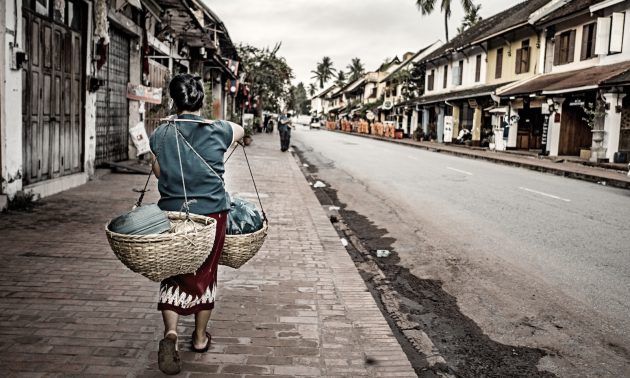Heavy debt load in Laos
Twenty years since the 1997 Asian financial crisis, analysts are once again looking skeptically at potentially unsustainable debt piles in the region. Largely untouched by the ’97 collapse, Laos could get pulled into a new era of financial turmoil.
An International Monetary Fund (IMF) report released this year said that the risk of “external debt distress” in Laos, Southeast Asia’s second smallest economy, has risen from “moderate to high.” The country owes for various big infrastructure projects, including foreign borrowing for massive hydropower dams.
The IMF found that Laos’ external public and publicly guaranteed (PPG) debt rose from US$5.4 billion in 2014 to about US$6.5 billion by the end of 2015, or roughly 52% of gross domestic product (GDP). The figure is estimated to be even higher now.
Debt sustainability concerns are rising as Laos’ recent fast economic growth, averaging around 8% from 2011 to 2014, has more recently started to taper off.
The Asian Development Bank (ADB) expects growth of 6.9% this year and around the same clip for 2018. Longer term, the IMF projects 6.3% average real GDP growth between 2016 and 2036.
There are several reasons for the decline, most not the government’s fault. Economic slowdowns in Laos’ main trading partners, including China, and lower global commodity prices are primary causes. Analysts also point to poor weather conditions over the last few years for a weakening agriculture sector.
But while growth rates contract, Vientiane will need to keep spending to reach its 2020 deadline for graduating from ‘Least Developed Country (LDC) status, a classification as of 2015 where gross national income per capita is below US$1,035.

One solution, analysts say, is to keep borrowing and hope for a new foreign investment driven economic uptick. The government’s budget plan through 2020 sets the national borrowing rate at 23.7% of GDP, a level analysts doubt the government can maintain at current spending rates.
While Laos remains classified as a LDC, debt repayment and servicing are largely under favorable low-interest terms. But when the country transitions from LDC status, the shift from concessional to market-based terms will put the government’s finances to a test.
There is certain official recognition of the problem. In October, Laos’ finance ministry successfully completed its largest ever bond issue via a US$419 million offering floated on Thailand’s debt markets.
Half of the raised capital is expected to be used for debt repayment; the other half is earmarked for funding infrastructure projects, according to media reports.
Boosting domestic revenue would also help to manage the debt pile. Last month, Prime Minister Thongloun Sisoulith instructed the finance ministry to “re-inspect” the state’s revenue sources, including taxes.
Tax collection dropped from 15.8% of GDP in 2013 to 14.3% last year. Imposing higher levies on businesses won’t be easy, though, as the economy starts to lose more steam.
Thongloun has personally headed a campaign to diversify Laos’ economic relations away from neighboring China, Vietnam and Thailand, its traditional main trade partners, to other richer regional countries.

In May, Thongloun traveled to Singapore to meet his counterpart Lee Hsien Loong, who committed to assisting Laos’ development. A week later, he oversaw this year’s Malaysia-Laos Business Forum in Kuala Lumpur.
Upon taking the premiership last year, Thongloun has persistently stated his ambition to transform Laos from being landlocked to “land-linked.” The China-financed Kunming to Vientiane high-speed railway, expected to be finished in 2021 and ultimately designed to extend to Singapore passing through Thailand and Malaysia, will contribute to that vision.
But there is only so much Thongloun can push in Laos’ nominally communist and patronage driven culture. Despite efforts to curb corruption, which have been emboldened under Thongloun’s tenure, analysts believe it will be extremely difficult to uproot what has become common practice over several decades.
“The opaque business environment and the presence of politically connected vested interests will make entry into some sectors difficult in the years ahead,” said Alice Mummery, an Asia Analyst at the Economist Intelligence Unit.
Others are cautiously optimistic. Yasushi Negishi, ADB’s country director for Laos, was recently quoted by Chinese media praising Vientiane for “curtailing spending and boosting private sector investments.”
Most economists agree that’s what it will take to alleviate mounting debts. What’s less clear, however, is how much austerity the government is willing to impose and how severely any financial downturn will be felt by ordinary people.

“With Laos’ economic picture not expected to be so bright in the coming years, there will be an increased risk of social unrest,” claimed Mummery.
Land concessions granted as incentives to private companies that involve the movement of populations are one risk factor.
Land-rights activism is on the rise in Laos. In one case, 14 villagers from southeastern Sekong province were arrested in recent months after protesting a ten-year-old land dispute involving a Vietnamese-owned rubber plantation.
For years, Vientiane has handed over state-owned land in lieu of debt payment to foreign investors. For example, when Vientiane couldn’t pay back a US$80 million loan China provided to build a stadium for the Southeast Asian Games, the government agreed to hand over a 300-hectare land concession to the contracted Chinese company.
Thongloun has said he wants to abolish the practice to dispel protests over land ownership. He has also moved to curb the growth of Chinese-run banana plantations in the country’s north where Chinese growers have been granted decades-long land concessions.
Some of Laos’ greatest economic potential is found in its land. Mining and farming remain dominant and hydropower could allow it to become a major power exporter. But it is these same foreign currency-generating industries that most infuriate locals, many of whom have come to think the government’s economic development schemes don’t have them in mind.
Source: http://www.atimes.com/article/heavy-debt-load-laos/


 Thailand
Thailand




